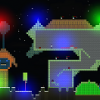public class CollisionLibrary {
public static boolean testAABBAABB(final AABB box1, final AABB box2) {
if (Math.abs(box1.center.x - box2.center.x) > (box1.r[0] + box2.r[0])) return false;
if (Math.abs(box1.center.y - box2.center.y) > (box1.r[1] + box2.r[1])) return false;
if (Math.abs(box1.center.z - box2.center.z) > (box1.r[2] + box2.r[2])) return false;
return true;
}
public static float sqDistPointAABB(final Vector p, final AABB aabb) {
float sqDist = 0.0f;
float v;
float minX, minY, minZ, maxX, maxY, maxZ;
// get the minX, maxX, minY, maxY and minZ, maxZ points of the AABB
minX = aabb.center.x - aabb.r[0];
maxX = aabb.center.x + aabb.r[0];
minY = aabb.center.y - aabb.r[1];
maxY = aabb.center.y + aabb.r[1];
minZ = aabb.center.z - aabb.r[2];
maxZ = aabb.center.z + aabb.r[2];
// test the bounds against the points X axis
v = p.x;
if (v < minX) sqDist += (minX - v) * (minX - v);
if (v > maxX) sqDist += (v - maxX) * (v - maxX);
// test the bounds against the points Y axis
v = p.y;
if (v < minY) sqDist += (minY - v) * (minY - v);
if (v > maxY) sqDist += (v - maxY) * (v - maxY);
// test the bounds against the points Z axis
v = p.z;
if (v < minZ) sqDist += (minZ - v) * (minZ - v);
if (v > maxZ) sqDist += (v - maxZ) * (v - maxZ);
return sqDist;
}
public static boolean testCircleAABB(final Circle circle, final AABB box) {
// get the squared distance between circle center and the AABB
float sqDist = sqDistPointAABB(circle.center, box);
float r = circle.radius;
return sqDist <= r * r;
}
}
Thanks,
I'm using a bog standard sphere to AABB collision detection as shown in the code. The issue I'm having is what to do when a collision occurs, for instance, if I move forwards and there is a collision, I then cannot move forwards which is correct, but if I turn around say 90 degrees and then move forward, I should be able to move, but cannot. I think you need to check the surface normals or something...








